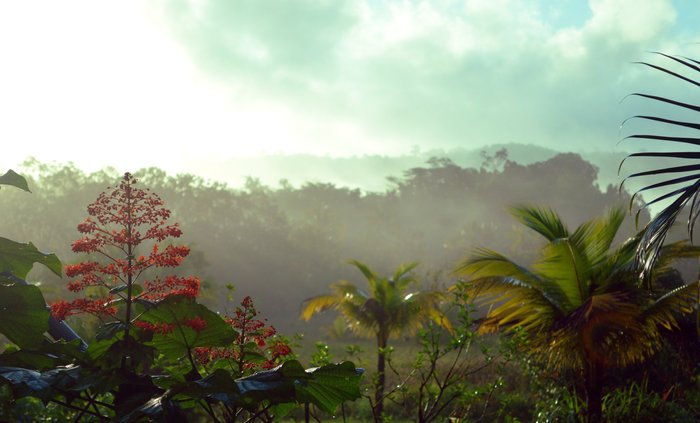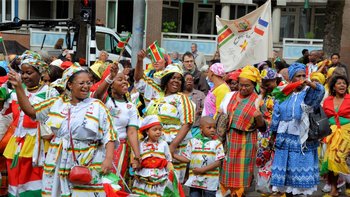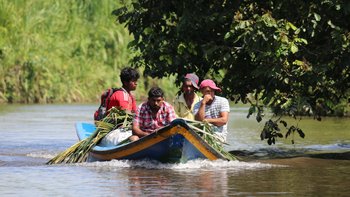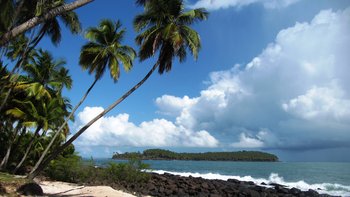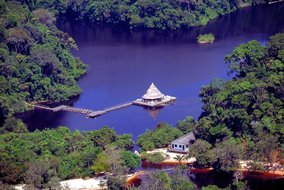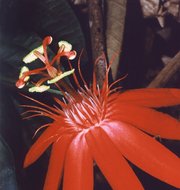Travel to the Guyana States: Rainforest and Adventure - INTI Tours
On the road in the "land of many waters
Are you looking for a still almost untouched country full of tropical flora and fauna in South America? Then come to the Guyana states of Guyana, French Guiana and Suriname. With almost 90 percent of tropical rainforests, they are among the few countries that are still largely undeveloped and have therefore been able to preserve their natural beauty and biodiversity to this day. Experience an adventure in fascinating untouched nature and listen to mysterious stories when travelling to the Guyana states.
Welcome - Bienvenue - Bienvenidos in den Guyanas!
Country information Absolutely worth seeing Facts and figures Travelling in the Guyana States Addresses
Our types of travel in the Guyanas
Examples of individual dream trips in the Guyana States
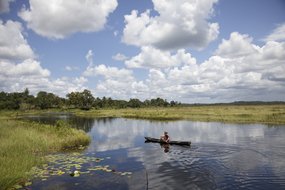
Guyana States individually: Pure Nature!
The journey through the Guyana States will take you to the mysterious and less known part of South America. The three countries Guyana, Suriname and French Guiana share an almost untouched rainforest landscape.
14 days Individualreise 2 up to 6 travellers
upon request
You might also like this...
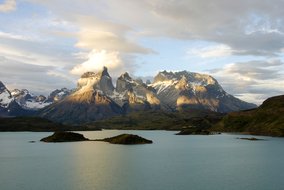
Rental Car Tour in Southern Chile and Patagonia
Rental car tour: Pablo Neruda once described his homeland Chile as a "thin land", which is on average only 180 km wide. And yet Chile is rich in impressive nature. Enjoy incomparable landscapes on this rental car tour in the south of Chile and Argentina.
14 days Bestseller 2 up to 4 travellers
upon request
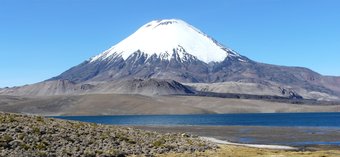
Chile en coche de alquiler por la Panamericana
Enjoy incomparable landscapes on this rental car tour along the Panamericana. Journeys from the coast to the highlands, the Lauca National Park, the Atacama Desert, the Pacific coastal landscape of Chile or the UNESCO World Heritage Site Isla Chiloé.
21 days Rundreise 2 up to 4 travellers
upon request
Country information on the Guyana States: "Land of Many Waters"
The so-called "Guyana States" or "Guyanas" include the three countries Guyana (formerly British Guiana), Suriname (formerly Dutch Guiana) and the overseas department of French Guiana. The name refers to the Guiana highlands that run through all three states. From the highlands, various rivers and streams flow down into the lowlands and eventually drain into the Atlantic Ocean. The indigenous people once named their homeland the "Land of Many Waters" after these countless watercourses. The Guyana states are located in the tropics on the north-east coast of South America.
Due to their geographical proximity and the same natural conditions, the following areas are also partially included under the collective term Guyanas: firstly, the Venezuelan region of Guayana (formerly Spanish Guiana), consisting of the present-day states of Amazonas, Bolívar and Delta Amacuro; secondly, the present-day Brazilian state of Amapá (formerly Portuguese Guiana).
Guyana:
Guyana is the westernmost of the Guyana states. The country borders Venezuela to the northwest, Brazil to the south and west, and Suriname to the east. On the border with Venezuela and Brazil rises the mountainous country of Guyana, after which the state was named, and where all the country's major rivers have their source. The main river is the Essequibo, which rises in the south of the country and flows into the Atlantic Ocean in the north. The 225-metre-high Kaieteur Falls are located in the Potaro National Park. 85 % of the country is sparsely populated and covered by lush tropical rainforest. Behind a swampy coastal strip is a 20 to 70 km wide alluvial zone where rice, sugar cane, coconuts and citrus fruits are grown. This is also where most of the population lives, with individual Indian tribes settled in the highlands.
Suriname:
Suriname is the middle of the three Guyana states and the smallest country in South America. It borders Guyana to the west, the Atlantic Ocean to the north, French Guiana to the east and Brazil to the south. The name most likely goes back to the indigenous Surin tribe. The land behind rises in several steps after a swampy coastal plain of a maximum width of 80 km, forming the so-called Suriname Plateau, which is part of the Guyana Highlands. From this, three mountain ranges rise in the southern area - the Wilhelmina Mountains, the Eilerts-de-Haan Mountains and the Tumuk-Humak Mountains. The Suriname, Saramacca and Coppename rivers as well as the Corantijn and Marowijne border rivers rise from the southern mountain region and drain into the Atlantic Ocean in the north. About 80 % of the lowland area is covered with tropical Amazon rainforest. The flora and fauna are overwhelming, for example caimans, jaguars, capybaras, sloths, tapirs, armadillos, various species of monkeys as well as countless bird species. The forests as a closed natural area are protected by state authorities and the WWF. Most of the population lives near the coast in villages and the capital Paramaribo.
French Guiana:
French Guiana is the easternmost of the three Guyana states, located on the Atlantic Ocean between Brazil and Suriname. French Guiana is not to be confused with the former French colony of French Guinea, now the Republic of Guinea. French Guiana is a fully integrated part of the French state and thus also part of the European Union, but not of the Schengen area. It thus has the largest contiguous forest area in France and the European Union. 90% of the country is covered with tropical rainforests. The area is part of the Guianese Highlands, which cover 1.5 million km² in the north-east of the South American continent. This highland has endemic flora and fauna due to its climatic isolation from the rainforest. In the south of the country, there is a smaller low mountain range with maximum elevations of around 800 metres, the so-called Massif Tabulaire. By far the largest part of the population lives on the coast, where the largest cities are located.
Absolutely worth seeing:
Guyana:
- Guyana's greatest attraction is the Kaieteur Falls, which are located in the heart of the country and are about five times higher than Niagara Falls. It takes about an hour by plane and then a moderate walk of about an hour.
- Guyana is still largely completely covered with tropical virgin forest, the flora and fauna display an enormous diversity of species and is particularly popular with birdwatchers and nature lovers.
- Pandama Retreat & Winery is a special place in the jungle with tree houses, hiking trails and delicious wines - a unique combination.
- The Iwokrama Canopy Walkway is something for daredevils, leading about 30 metres above the ground across the canopy of the tropical forest.
- In the capital Georgetown, St George's Cathedral is a must-see, the impressive colonial cathedral is the oldest wooden building in the city.
- You can book various excursions from Georgetown to the surrounding area, e.g. a bicycle tour to the Kanuku Mountains and Kumu Falls, a horseback riding tour in the Lethem Savanna, an excursion to the Sloth Island Nature Resort and others.
Suriname:
- In the capital Paramaribo - UNESCO World Heritage Site - you can marvel at the Dutch colonial architecture of the wooden buildings in the city centre: Presidential Palace, Fort Zeelandia Museum, the so-called Corner House, the Synagogue and the Mosque. The Central Market is also worth a visit.
- Various excursions are offered from the capital, e.g. to the Browns Mountains with waterfalls and hiking opportunities.
- Many animals can be seen in the Peperpot Nature Park.
- Boat tour on the Commewijne River into the jungle landscape to the freshwater dolphins.
- A trip to Brownsberg and Stuwmeer takes you into the unique jungle and offers on-site boating, fishing, Brokopondo Lake, wildlife viewing, hiking opportunities, etc.
French Guiana:
- A visit to the Marshes of Caw is wonderful for all nature and bird lovers. Boat trips, walks and wildlife watching await visitors.
- South of the capital Cayenne is the Sentier du Rorota beach, which can be visited by hiking. Sloths are said to be very easy to see here.
- The Zoo de Guyane is well worth a visit.
- The long Rémire-Montjoly Beach is ideal for swimming - also for families.
- On the coast lies the offshore archipelago Îles du Salut - the Salvation Islands. The most famous island of the archipelago - Devil's Island - became known worldwide through the release of the film "Papillon".
- The island of Ilet la Mere is a wonderful place for hiking and monkey watching.
- Le Morpho boat tour with wonderful wildlife viewing opportunities.
- For every fan of space travel, the Kourou Space Centre (Guiana Space Centre) is a must! You can learn a lot about the processes and everyday life at ESA. It's also good to ask when the next rocket launch will take place.
Facts and figures of the Guyanas:
Land area Guyana: 214,970 sq km
Land area Suriname: 163,820 sq. km
Area of French Guiana: 83,534 sq km
Population Guyana: just under 740,000 - approx. 44 % people of Indian descent, a good 30 % Creoles, 16.7 % of mixed descent, 9.2 % indigenous peoples, the rest are Chinese, Portuguese and other Europeans
Population Suriname: about 542,000 - about 37.4 % of African origin, 27.4 % of Indian origin, 13.7 % people of Indonesian descent, the rest are mixed race or people of other origins (e.g. China, Arabia)
Population French Guiana: just under 270,000 - ethnically very mixed, predominantly Creoles and Afro-Guyans
Capital Guyana: Georgetown
Capital Suriname: Paramaribo
Capital French Guiana: Cayenne
Highest mountain in Guyana: the Roraima-Tepui at 2,810 m.a.s.l.
Highest mountain in Suriname: the Julianatop at 1,280 m.a.s.l.
Highest mountain in French Guiana: Bellevue de l'Inini at 831 m.a.s.l.
Form of government Guyana: Republic, semi-presidential democracy
Form of government Suriname: representative democracy with parliamentary executive power
Form of government French Guiana: Semi-presidential democracy
History of Guyana: In the 17th and 18th centuries, the Dutch colonies of Essequibo, Demerara and Berbice. In 1763, there was a slave revolt in Berbice under Cuffy, now revered as a national hero. Until 1815, the claim to ownership changed several times between the colonial powers of the Netherlands, Great Britain and France. After the defeat of Napoleon Bonaparte, the three colonies were transferred to the United Kingdom of Great Britain and Ireland at the Congress of Vienna in 1815. In 1831, the colony of British Guiana was founded from this. On 1 August 1834, slavery was abolished. After the loss of labour on the plantations, the British engaged contract labourers from British India. Guyana achieved independence from the United Kingdom in 1966 and was declared a Cooperative Republic by the People's National Congress in 1970.
History of Suriname: Of the indigenous peoples, the largest tribes were the Arawak and the Caribs. Christopher Columbus was the first European to discover the coast in 1498, Vicente Yáñez Pinzón explored the interior in 1500. The first European settlers were the English in 1651, and the Netherlands took the colony in 1667. While the Netherlands was annexed to France, the British occupied Dutch Guiana in 1799-1802 and 1804-1815. The present territory of Suriname was returned after Napoleon's defeat, while present-day Guyana remained in the possession of Great Britain. In 1954, Suriname, like the Netherlands Antilles, was given the status of an equal and self-governing part of the Kingdom of the Netherlands. In 1973, the local administration began negotiations with the Kingdom of the Netherlands for independence, and Suriname became independent in 1975.
History of French Guiana: About 100 years after Christopher Columbus arrived in the Guayas, the first European settlers from the Netherlands settled there at the end of the 16th century. Later came the French and the English. In 1946, French Guiana became an integral part of France as an overseas department and thus received limited self-government.
Economy Guyana: The most important export product is bauxite; timber, diamonds and gold are also exported. In the coastal region, rice, sugar, tropical fruits, shrimps and rum are produced for export. By 2020, 13 oil fields with an estimated total volume of 5 to 10 billion barrels of oil have been discovered off the coast of Guyana.
Economy Suriname: At the time of colonisation, Suriname was a profitable sugar plantation colony of the Netherlands. Today, bauxite and mineral oil are the most important export goods, along with gold, wood, rice, bananas and fish.
Economy French Guiana: Together with the French space agency CNES, ESA operates the Centre Spatial Guyanais spaceport in Kourou. Arianespace launches Ariane launchers with communication satellites and other payloads there. Forestry is an important economic sector in the country because of the tropical rainforest. Otherwise, only crab fishing and gold mining are worth mentioning.
Guyana's main exports: bauxite
Main exports Suriname: bauxite
Main exports French Guiana: The spaceport is the main pillar of French Guiana's economy.
Currency Guyana: Guyana dollar
Currency Suriname: Suriname dollar
Currency French Guiana: Euro
Language Guyana: Apart from English, eleven other languages have the status of an officially recognised language. Colloquial language is a creolised English as well as Indian languages (especially Hindi) and Indian languages.
Language Suriname: Dutch (= official language), English, Sranang Tongo
Language French Guiana: French
Feasts Guyana States: In all three countries, the festivals of the various religions of the population are celebrated, such as Christian, Islamic and Hindu.
Travelling in Guyanas:
Entry requirements Guyana: When entering Guyana, German citizens must have a passport that is valid for six months beyond the date of travel. The requirements of individual airlines regarding the documents to be carried by their passengers differ in part from the government regulations. Therefore, please check with your airline before travelling. German nationals do not require a visa to enter Guyana for a stay of up to 90 days. Air travellers should be in possession of an onward or return ticket.
Entry requirements Suriname: When entering Suriname, German citizens must have a passport valid for six months beyond the date of travel. The requirements of individual airlines regarding the documents to be carried by their passengers differ in part from the government regulations. Therefore, please check with your airline before travelling. German nationals require a so-called E-Visa to enter Suriname for tourist purposes. This must be applied for online before entering the country. The visa allows a maximum stay of 90 days in Suriname.
Entry requirements for French Guiana: For German citizens entering the country, their passport must be valid for six months beyond the date of travel. Members of the European Union and Switzerland do not require a visa for entry into French Guiana and a stay of up to 90 days. Air travellers should be in possession of an onward or return ticket.
Vaccinations Guyana: No compulsory vaccinations are required for direct entry from Germany. If entering from a yellow fever area, proof of yellow fever vaccination must be provided. In addition, proof of yellow fever vaccination may be required for subsequent onward travel to some third countries, as Guyana itself is one of the yellow fever areas. You are strongly advised to have a yellow fever vaccination before entering Guyana. Make sure that you are up to date with all standard vaccinations according to the vaccination calendar of the Robert Koch Institute. Vaccinations against hepatitis A are recommended as travel vaccinations, as well as against hepatitis B, typhoid and rabies for long-term stays or special exposure.
Vaccinations Suriname: A valid yellow fever vaccination may be required for all travellers when travelling on to other countries in South America, or to sub-Saharan Africa, as yellow fever transmission is possible in Suriname. Make sure that you are up-to-date with all standard vaccinations according to the vaccination calendar of the Robert Koch Institute. Vaccinations against hepatitis A, hepatitis B, typhoid and rabies are recommended for long-term stays or special exposure.
Vaccinations French Guiana: A vaccination certificate against yellow fever is required from all entrants over one year of age. The only exception is for transit passengers in French Guiana who do not leave the transit area. Make sure that you are up to date with all standard vaccinations according to the vaccination calendar of the Robert Koch Institute. Vaccinations against hepatitis A are recommended as travel vaccinations, and also against hepatitis B, typhoid and rabies for long-term stays or special exposure.
Climate & travel time Guyana: The climate is tropical with rainfall of up to 3,000 mm per year. The average annual temperature is 27° Celsius and the humidity is 73-88 %. A stronger rainy season is from April to August, a weaker one from September to November, and a stronger one again until the end of January. February to the beginning of April is considered the dry season and is therefore the best time to travel to the Guyanas.
Climate & travel time Suriname: The climate is tropical-warm and humid. It is hot all year round, the succession of rainy and dry phases determines the seasons. A total of four seasons can be distinguished along the coast. The best times to visit Suriname are during the two dry periods from the beginning of February to the end of April and from mid-August to the beginning of December. Especially in September and October, an average of only nine rainy days can be expected. With around 80 mm of precipitation per month, these are also the driest months. It is also only possible to go on tours into the interior of the country during the dry season. During the rainy season, the roads are often flooded. If you want to watch the sea turtles lay their eggs and not get completely soaked, you should visit the country in March and April.
Climate & travel time French Guiana: French Guiana can be visited all year round. It is located within the tropics and therefore has high temperatures all year round. The average temperature is 28 °C... The best time to travel is between June and early December. The dry season is from about August to December, although here too you must expect sudden tropical downpours every day. These do not usually last long. In the other months, the rainy season prevails. Due to the large area of rainforest in the south and west, the humidity is 80-90%.
Local time Guyana: CET -5 hrs. CEST -6 hrs.
Local time Suriname: CET -4 hrs. CEST -5 hrs.
Local time French Guiana: CET -4 hrs CEST -5 hrs.
Addresses:
Guyana:
Embassy of the Cooperative Republic of Guyana
Boulevard Brand Whitlock 114, 3rd Floor
1200 Brüssel
Tel +32 2 675 62 16
info@embassyofguyana.be
embassy9.guyana@skynet.be
Ministry of Foreign Affairs Guyana
https://www.minfor.gov.gy
Suriname:
Embassy Suriname
Avenue Franklin Roosevelt 200
1050 Brüssel
Tel 0+32 2 640 11 72
amb.belgie@foreignaffairs.gov.sr
Ministry of Foreign Affairs Suriname
https://www.auswaertiges-amt.de/de/aussenpolitik/laender/suriname-node
French Guyana:
French Embassy
Wilhelmstraße 69
10117 Berlin
Tel +49 (0) 30 590 03 9085
French Consulate
Schloßstrasse 51
70174 Stuttgart
Tel +49 (0) 711 23 925 53
https://de.ambafrance.org


